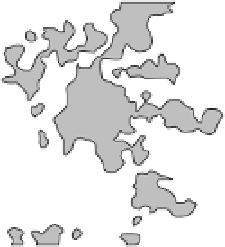Environmental Engineering Reference
In-Depth Information
such as changes in vegetation over time and subsurface
spatial patterns of a range of phenomena such as soil
hydraulic properties, nutrient levels, and plant root and
invertebrate biomass. Only if a model can be shown to
reproduce multiple patterns can we be confident that it
provides a plausible explanation of how a system behaves.
It is particularly with subsurface patterns that insuf-
ficient progress has been made in model development
and testing. Vegetation patterns may look very striking,
and it is tempting to think that subsurface patterns will
necessarily mirror those at the surface but that may not
be the case and the search for subsurface patterns may
reveal key features of the ecohydrological functioning
of a hillslope that have been missed in a simple model.
This point is nicely made by Mueller
et al
. (2007) in a
modelling study that suggests that vegetation boundaries
between shrubland and grassland in drylands may not
be reflected in soil variables such as water and nutri-
ent content. Interestingly, Mueller
et al
. (2007) found
that particular vegetation types did not behave as sinks
for all resources. For example, in boundaries between
shrubland and grassland, their model showed that the
grassland gained water from the upslope shrubland and
also nutrients but lost the nutrients downslope from the
area near the boundary because of increased overland flow
caused by the additional water received from the shrub-
land (compared to that which would be received from
an upslope grassland). Mueller
et al
. (2007) hypothesize
that the stability of boundaries will depend on how water
and nutrient fluxes across the boundaries and nutrient
cycling within patches increase or reduce the competitive
advantage of each vegetation type, with the important
point being that subsurface patterns may reveal incipient
instability (or a system close to a threshold of change)
when surface patterns do not. A model that ignores the
subsurface or assumes that subsurface properties map
directly onto surface vegetation patterns may, therefore,
be in error and produce misleading results. Some authors
have started to test their models by looking at multiple
patterns, including those below the surface, in the manner
suggested by Grimm
et al
. (2005). Thus, for a model of
peatland surface patterning, Eppinga
et al
. (2008) were
able to show that not only did the model predict plausible
surface patterns of vegetation, it also produced patterns
of water-table position and nutrient concentrations that
were similar to those observed in a Siberian peatland.
But such cases of multiple pattern testing are still rare
and their rarity emphasizes the need to explore in more
detail patterns of subsurface properties. It is with such
subsurface patterns that the next section is concerned.
10.3 Nobody loves me, everybody hates
me
...
Nobody loves me, everybody hates me,
Think I'll go and eat worms.
Big fat squishy ones,
Little thin skinny ones;
See how they wriggle and squirm
(Anon)
Vegetation patterns in drylands and peatlands are easy to
see. Outwith drylands and peatlands, vegetation patterns
might be quite subtle. For example, heathland dominated
by heather (
Calluna vulgaris
(L.) Hull) often looks like
a simple, homogenous 'monoculture', but patterns may
be evident on closer inspection. Figure 10.3, taken from
Diggle (1981), shows such a pattern, with variations in
heather cover and patches of bare soil between heather
plants. Single-species stands of vegetation may also show
pattern in terms of age of the individuals of that species
and in terms of the physiology or health of the species (
cf
.
Hendry and McGlade, 1995).
Nothwithstanding such subtlety in surface patterns, it
is important to recognize that patterns may occur below
the ground surface even when they are not very evident at
or above the surface in the vegetation. For example, when
plant cover is seemingly uniform, roots and root networks
may be highly nonrandom spatially and may affect water
flow and storage in a number of ways not suspected from
the lack of surface pattern. A high density of roots might
be associated with high rates of water flow during storm
events because the roots create macropores. Somewhat
counterintuitively, a high density of roots might also
be associated with enhanced water storage. A high root
Figure 10.3
Presence of heather (
Calluna vulgaris
(L.) Hull
(shown by shading) in a 10
20 m plot area, Jadraas, Sweden
(Reproduced with permission from Diggle, P.J. (1981) Binary
mosaics and the spatial pattern of heather.
Biometrics
, 37,
531-9).
×






















Search WWH ::

Custom Search